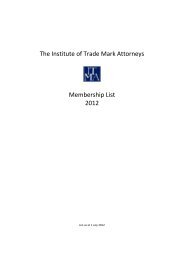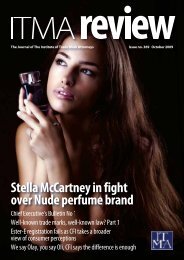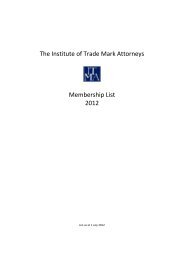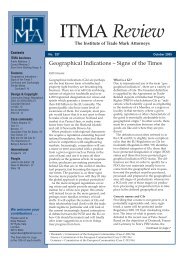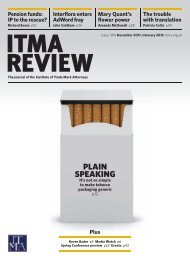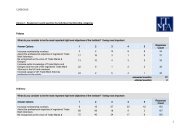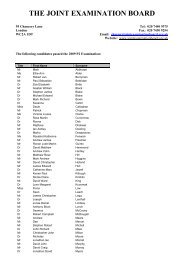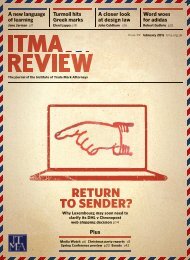ITMA 322 APRIL 2005
ITMA 322 APRIL 2005
ITMA 322 APRIL 2005
Create successful ePaper yourself
Turn your PDF publications into a flip-book with our unique Google optimized e-Paper software.
fully registered if there were an additional element to<br />
support it, which again cannot be phonetically or conceptually<br />
identical or similar to any other marks. The<br />
word APOLLO is the name of a Roman god and<br />
EXCEL is laudatory of the goods. I believe that these<br />
Pass the dictionary, would you?<br />
CASE COMMENTS<br />
terms should be left free for others traders to use<br />
them to describe their goods/services.<br />
Remya Suresh, Ravindran Associates, Singapore,<br />
remya@ipravi.com<br />
Decision O-253-05 GA Modefine’s Opposition (Trade Marks Registry) 12 September <strong>2005</strong><br />
The review of European case law in this decision of<br />
the Appointed Person Geoffrey Hobbs QC rejecting<br />
an opposition to an application for UK protection for<br />
the word mark LE SPOSE DI GIO’ demonstrates that<br />
an international mark will not be refused protection<br />
in the UK merely because it is descriptive in the language<br />
of another EU member state and that the UK<br />
Registry will be slow to infer confusion between<br />
opposing marks from their descriptiveness in another<br />
language. However, as we shall see, that does preclude<br />
other elements from rendering opposing word<br />
marks in a foreign language from being sufficiently<br />
similar so as to give rise to a likelihood of confusion.<br />
Background<br />
On 16 November 2000 Di Gio’ Srl requested protection<br />
in the UK for the international trade mark LE<br />
SPOSE DI GIO’ in relation to clothing of all types,<br />
including bridal gowns, formal wear etc. The request<br />
was opposed by GA Modefine SA, who owned the<br />
earlier Community trade marks ACQUA DI GIO’ and<br />
GIO’, on the grounds that because of the similarities<br />
in the marks and in the goods there existed a likelihood<br />
of confusion under s 5(2)(b) of the Trade Marks<br />
Act 1994.<br />
In allowing the opposition, the hearing officer<br />
rejected Di Gio’s claims that GIO’ was a well-known<br />
trade mark synonymous with GIORGIO ARMANI.<br />
On the basis that the mark was used mainly in relation<br />
to websites with the suffixes .com and .it and<br />
Italian language magazines in circulation in the UK,<br />
the hearing officer held that the mark was primarily<br />
used in a context requiring familiarity with the Italian<br />
language and that the relevant public therefore consisted<br />
of Italian speakers in the UK. In his view, LE<br />
SPOSE would be taken as descriptive of the goods in<br />
question and, although ACQUA DI GIO’ and LE<br />
SPOSE DI GIO’ differed in their first elements, that<br />
difference was counterbalanced, to an extent, by the<br />
descriptive nature of those elements. He concluded<br />
that consumers would be led to believe that the goods<br />
sold under both marks originated from the same<br />
source.<br />
Grounds of appeal<br />
Di Gio’ appealed on the basis that the hearing officer<br />
should not have taken into account that LE SPOSE<br />
was likely to be taken as descriptive by those whose<br />
exposure to the mark was through the medium of<br />
Italian magazines circulating in the UK; nor should he<br />
have concluded that the importance of the DI GIO’<br />
element of the mark had been actively made known<br />
to consumers. Di Gio’ contended that the hearing officer<br />
had no adequate reason to conclude that the average<br />
consumer would understand LE SPOSE to be<br />
descriptive. In their view, the hearing officer was<br />
wrong to have given any weight to the fact that the<br />
use of the mark LE SPOSE DI GIO’ had taken place in<br />
an Italian context.<br />
The Appointed Person’s approach<br />
The Appointed Person dismissed the appeal, although<br />
he did not agree entirely with the hearing officer’s<br />
reasoning, particularly the view that the relevant public<br />
would be familiar with Italian. He noted that the<br />
ECJ had confirmed that, when assessing requests for<br />
protection of a trade mark at a national level, it was<br />
necessary to look at social, linguistic and cultural differences<br />
between member states (see Estée Lauder<br />
Cosmetics GmbH v Lancaster Group GmbH [2000] ECR I-<br />
1117). It was not correct to assume that refusal or<br />
acceptance of registration in one member state was<br />
enough to justify similar treatment in another. He<br />
noted that the relevant language for the purpose of<br />
testing whether a word mark is acceptable for registration<br />
is the officially recognised national and any<br />
regional languages of the territory for which protection<br />
has been sought (see POSTKANTOOR [2004]<br />
ETMR 57). Hence the approach taken by the Court of<br />
First Instance in Case T- 286/02 Oriental Kitchen v<br />
OHIM when considering whether the mark KIAP<br />
MOU conflicted with earlier registrations of the word<br />
MOU, which in Laotian and Thai happens to mean<br />
“pork” whilst KIAP means “crispy”. This was that no<br />
account need be taken of the applicant’s assertion that<br />
the goods referred to in the application were intended<br />
for clientele of Chinese of Indochinese origin living in<br />
Western Europe.<br />
It was clear to Geoffrey Hobbs that the same<br />
approach should be taken in the current case. In the<br />
light of Oriental Kitchen (and also Case C-3/03 P<br />
Matratzen v OHIM), he concluded that in principle it<br />
is impermissible for English equivalents of foreign<br />
words to be used for the purpose of testing issues<br />
relating to the distinctiveness, descriptiveness or<br />
deceptiveness of such words in the UK in the absence<br />
of good reason for thinking significant proportion of<br />
the relevant, predominantly Anglophone, public<br />
would understand their meaning.<br />
Decision<br />
Having said all that, Geoffrey Hobbs still found the<br />
opposing marks sufficiently similar as to give rise to a<br />
Continued on page 18<br />
December <strong>2005</strong> <strong>ITMA</strong> Review 17





